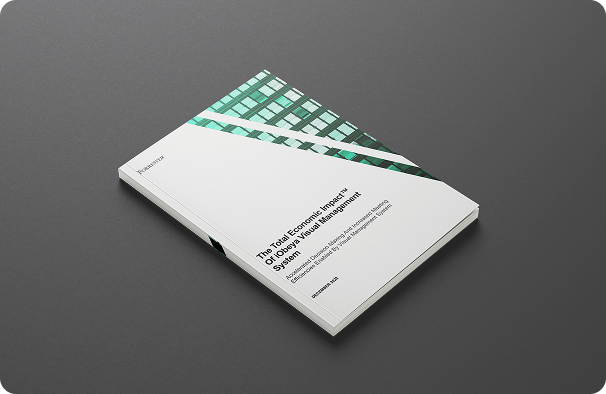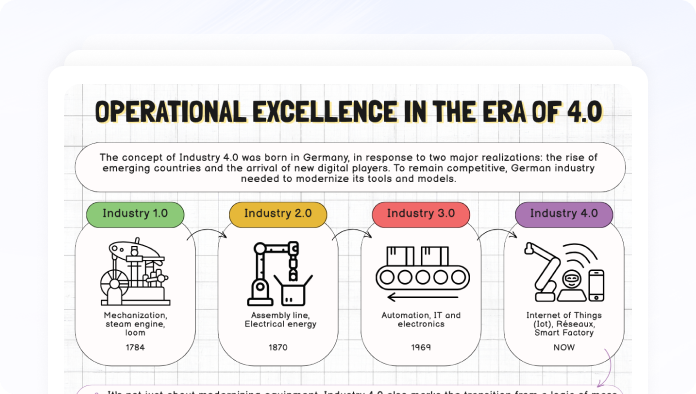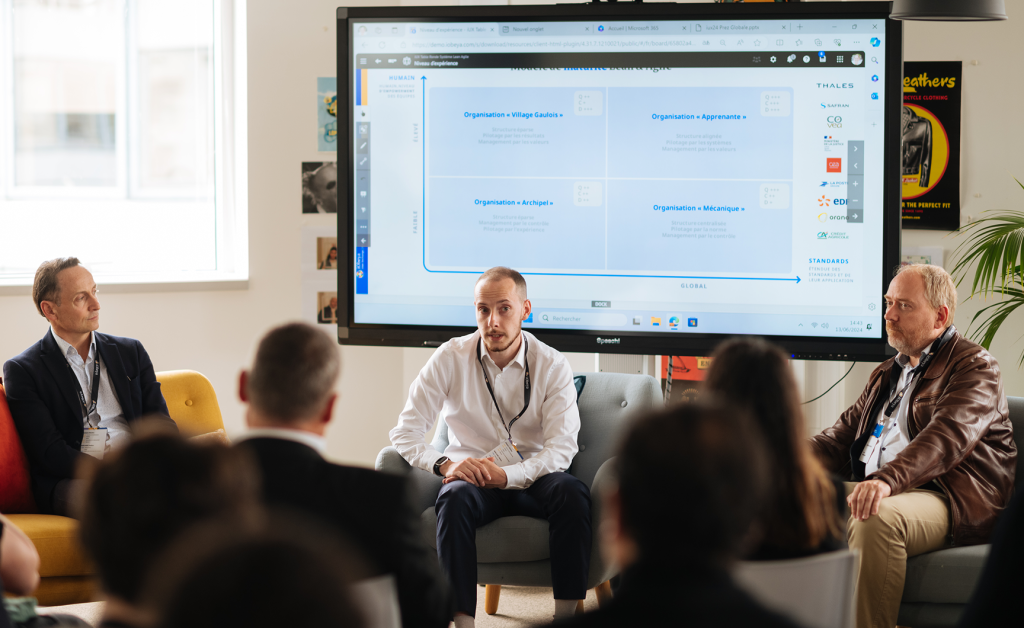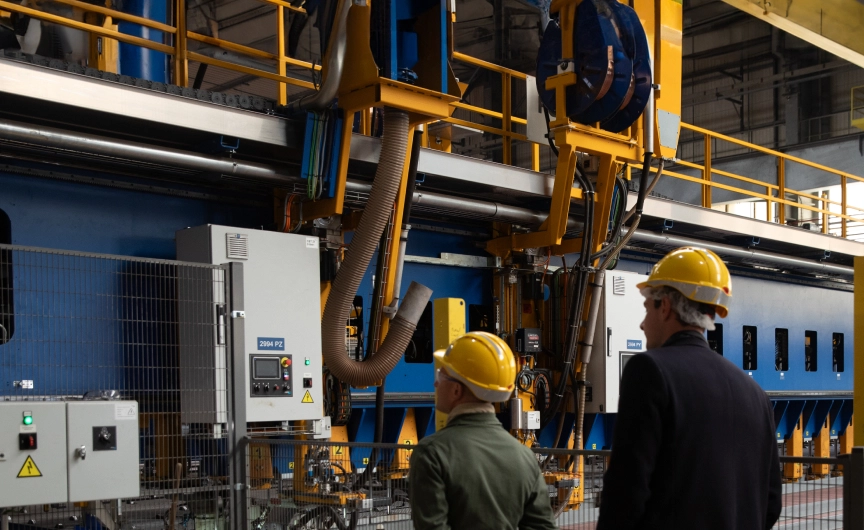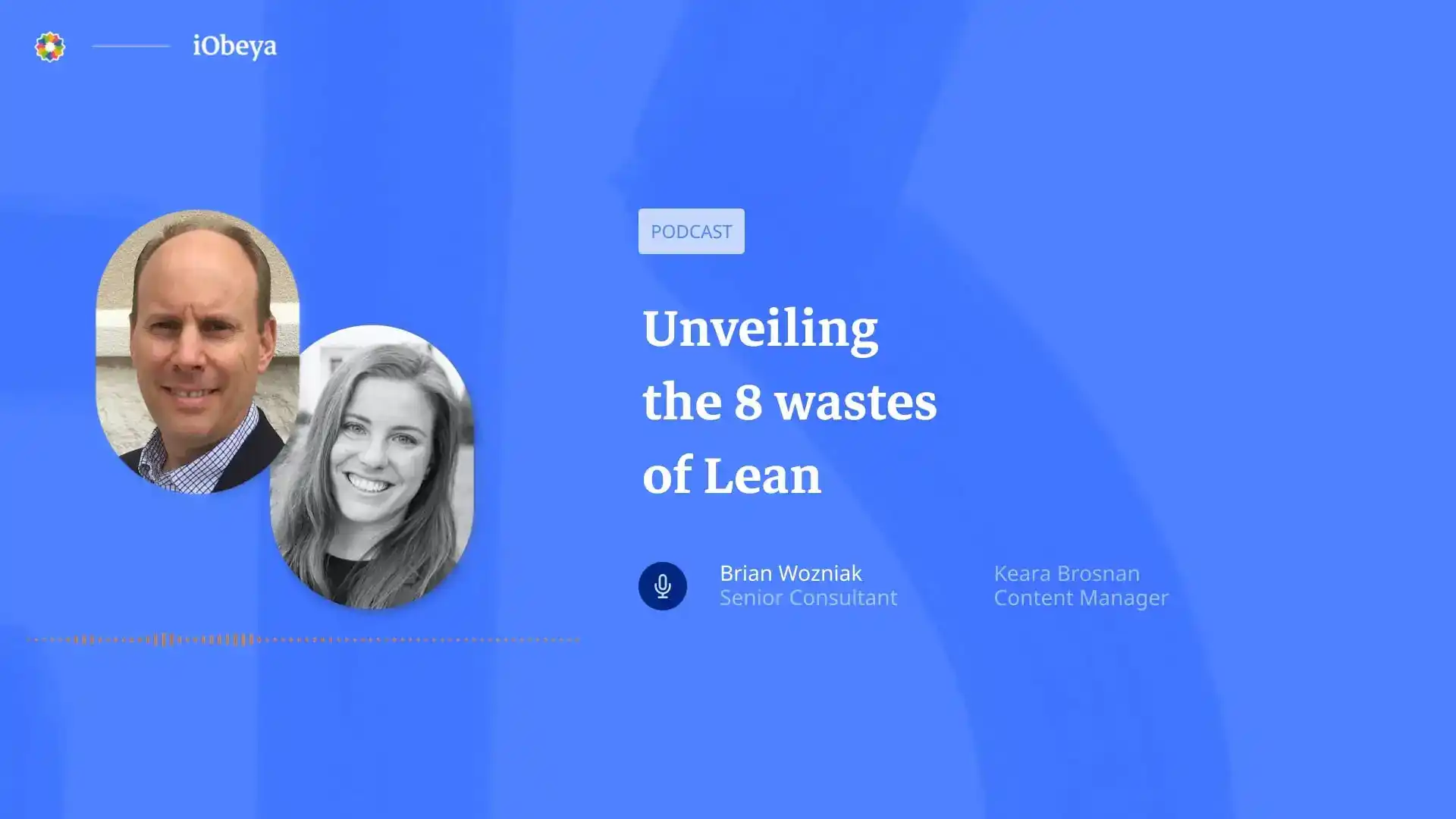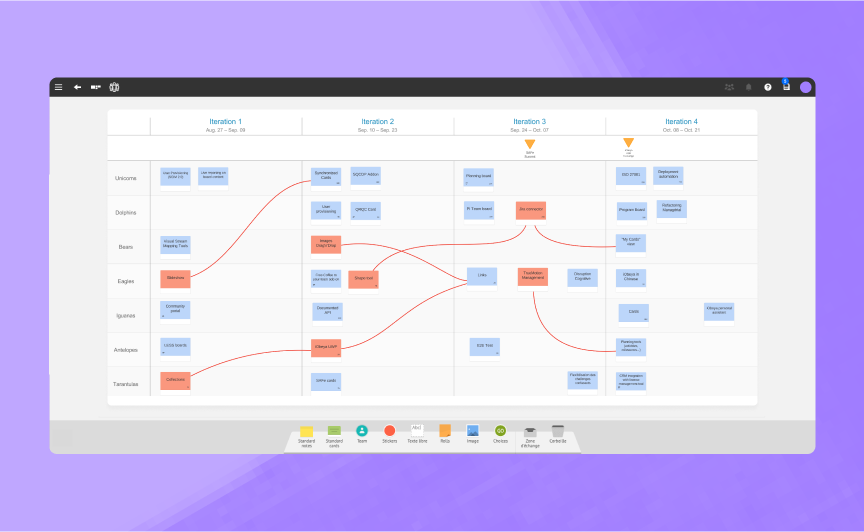Hey, let’s start your
iObeya journey!
Adopting a Lean culture is more than just implementing tools or streamlining processes. Above all, it is a question of an in-depth transformation of organizational culture, management and collaboration methods. But how do you assess where an organization is in this journey?
Among the many approaches available to assess Lean maturity, we offer here a simplified matrix. It does not claim to be exhaustive, but constitutes an accessible entry point to situate oneself in a global way and to initiate reflection.
The Lean maturity matrix thus offers a useful first reading grid for diagnosing the major stages of this evolution.
And that’s good: we have already experimented with this tool during a workshop with several customers to help them position themselves. Now it’s your turn: let’s explore together where your company is in its Lean journey.
What is the Lean Maturity Model?
Lean maturity models are assessment tools that allow organizations to measure their progress in adopting Lean principles, such as reducing waste, continuous improvement, and creating value for the customer.
This matrix is used to diagnose the level of maturity of a company in two main areas, in order to identify the levers for improvement and to guide transformation efforts.
The objective is to orient the organization towards sustainable operational excellence, based on a progressive and structured approach, adapted to its context and its capacity for change.
Lean Maturity: between team autonomy and the dissemination of standards
The Lean maturity matrix is based on two key dimensions:
- The level of “empowerment” of the teams : This refers to their degree of autonomy, accountability, and commitment. The more teams are able to take initiative and act on performance levers, the more they contribute to the Lean dynamic.
- The scope of Lean standards and their application : This criterion evaluates the maturity of the Lean system in general, as well as its standards – are they local or are they deployed globally and homogeneously in the organization?
These two axes make it possible to position an organization in one of the four maturity dials that we will see now.
Analysis of which Lean Maturity Model we are in
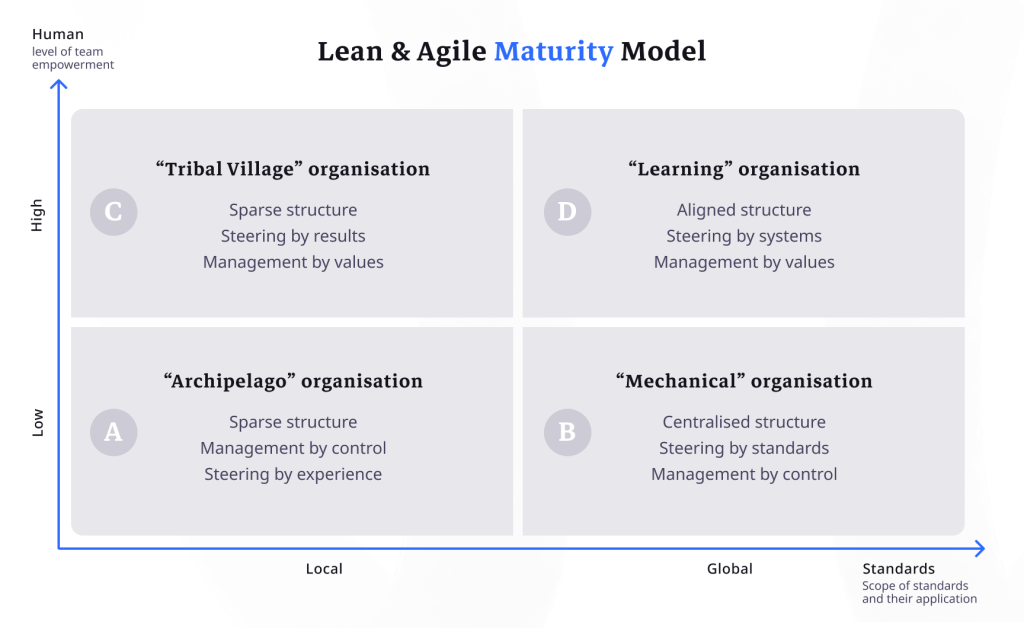
The Lean maturity model presented in this diagram is a diagnostic and strategic thinking tool for assessing an organization’s progress towards a successful Lean culture.
The "Archipelago" organization: islands of initiatives, without a common direction (Bottom left)
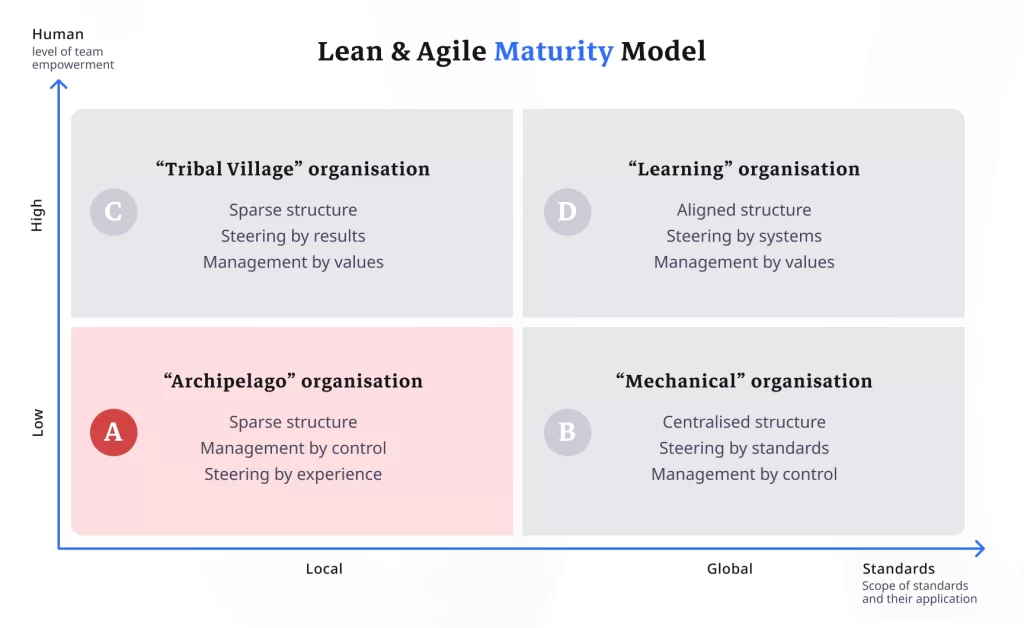
This section reflects an organization where Lean is applied in a punctual and localized way, the commitment of teams being limited, or even low, which hinders the sustainability of practices, which are very “nobody” dependent.
Let us imagine an organization composed of many small units, dispersed, independent, sometimes even invisible to each other. Each operates according to its own priorities, under the strong impetus of its director, who often comes from the technical ranks. The managerial culture has a traditional imprint, with a concentration of decision-making power on the “knower(s)”.
Welcome to the “Archipelago” organization.
Here, we often find so-called “networked” companies, made up of small operational units distributed over a given territory, to guarantee its “network”.
This type of model tends, especially in the initial growth phases, to base its competitive advantage on the entrepreneurial spirit and customer proximity. Good commercial links are forged with the territory and the customer is generally satisfied.
In this context, much depends on the head of the site, who is not very accountable “at headquarters” for how his unit works in practice. If he presents “good figures” in terms of P&L and OWC, he will not be asked any questions.
Lean maturity is by design heterogeneous, with sites that can be quite mature, under the impetus of their boss, but also display a very traditional management style.
Each site does what it can, as it can, with what it has.
At the company level, there will be no common standards, there will be little transversality and, in general, little dialogue between the sites (blocks).
It is a territory of exploration, often creative, but fragile: initiatives are born, but struggle to last and remain very dependent on the site manager. There is no guarantee that what has been built by the owner of a site will not be dismantled by his successor.
In this configuration, the risk is clear: each island site is “getting by”, but the company, as a whole, is not really making progress. We try, we test, we give up. And often, the frustration of the teams grows, especially when you compare the results to the energy invested.
To get out of the “Archipelago”, you must:
1) lay down a methodological and cultural basis common to all site owners. We need to identify the units where it works, and make examples of them. Local bosses/”barons” are supposed to see Lean as a real opportunity to (re)motivate teams and impact results.
2) facilitate the sharing between island sites of standards that are effective for all and, possibly, to promote a certain direct operational collaboration and the pooling of certain resources, if this proves beneficial.
It is not strength that allows the archipelago to transform into a continent, but connection, trust, and common storytelling.
The transition to a more structured culture then requires time, listening, and often targeted support so that everyone understands how their island can become an island connected to a larger whole.
The "Mechanical" organization: oiled, framed... but frozen (Bottom right)
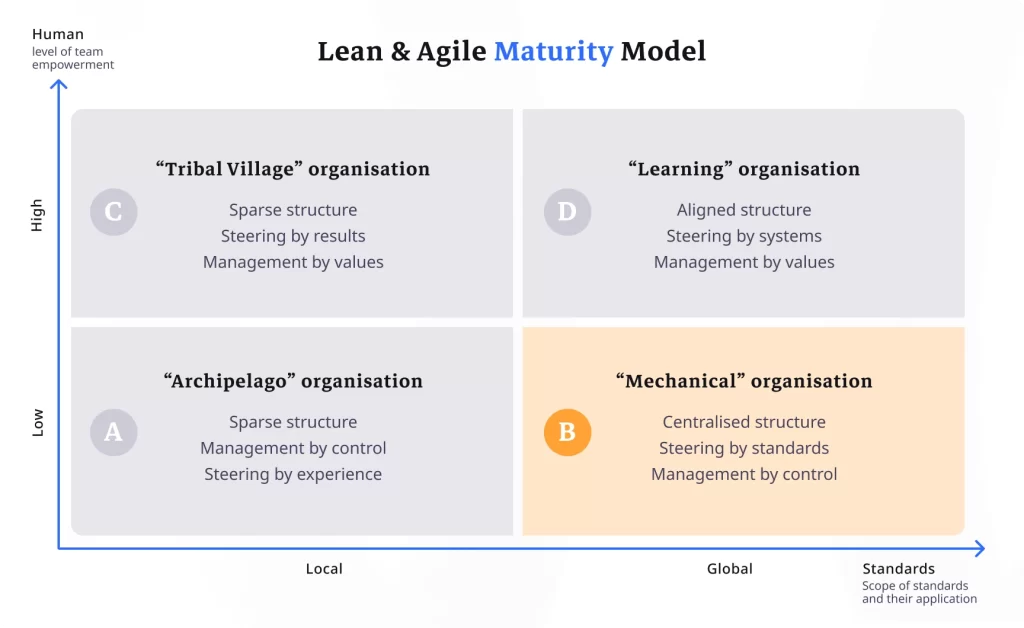
Here, Lean standards are widely deployed but applied in a rigid and top-down way, without any real appropriation by the teams. This configuration generates static stability, a conformist culture, and control-oriented digitalization, which hinder innovation and adaptability.
Imagine a perfectly orderly organization. Every process is documented, every indicator scrutinized, every action planned. The rituals are in place, the Lean standards are well deployed, the dashboards impeccable. On paper, everything works.
Welcome to the “Mechanics” organization.
Here, Lean is serious, rigorous… but often experienced as an obligation. Daily meetings take place, but dialogue is sometimes frozen. The indicators are monitored, but rarely questioned. Continuous improvement exists, but within a very standardized, almost locked framework.
In this type of organization, the commitment comes from the top. The management drives, structures, deploys. But on the ground, the teams lack autonomy. They apply, but don’t always dare to propose. The posture remains descending, sometimes even a little cold. Lean becomes a well-oiled machine, but not very lively.
And yet… This model has its strengths:
- High stability.
-
Consistent results, especially in quality and compliance.
-
An ability to stay the course, even in a demanding environment.
But it quickly reaches its limits when the environment changes, when it is necessary to innovate, adapt, and cooperate in a transversal way. Standards then become brakes rather than support. And innovation is running out, because it can’t find the space to emerge.
In a mechanical organization, the risk is running out of steam. We work, but we no longer evolve. The system works, but without the human engine.
So, how do you take the next step?
It is not a question of dismantling the machine, but of making it more flexible. To introduce more listening, more room for manoeuvre. To reconnect standards to the field, to co-construct them with the teams. To reinject meaning into rituals.
It is by giving a voice to those who do, by creating a space for initiative, that the organization can move from mechanics to learning. No longer a well-tuned machine, but a living system, capable of learning, evolving and transforming.
The " Tribal Village": when commitment is no longer enough (Top left)
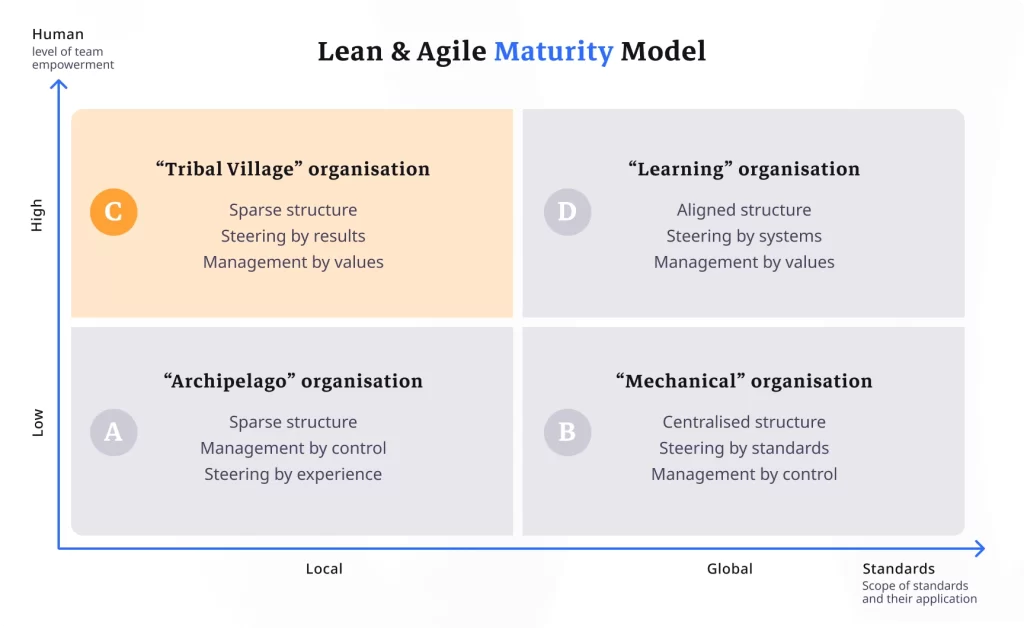
In this case, the teams are very involved and committed, but the practices remain localized. The organization benefits from high adaptability, but also suffers from instability and a hero culture, where results depend too much on key individuals. Digitalization is fast but not very integrated.
“We have a high degree of autonomy, but each entity moves forward according to its own practices. Heterogeneity is an obstacle to sustainability.” says a customer.
Imagine a company with multiple departments, each with its own rituals, ways of working, and most importantly, its own Lean culture. In some corners of the organization, we feel a real breath of fresh air: committed, proactive teams that take the lead to improve their daily lives. We see well-kept visual panels, effective meetings, results on the agenda.
These teams are the local heroes. Inspiring managers, driving employees. Thanks to them, Lean lives. But a few offices away… radio silence. Other teams are struggling to keep up. Not out of ill will, but for lack of framework, lack of relay, lack of coherence. Everyone is moving forward as best they can, without a common compass.
This is what we call the “Gallic Village” : an organization where excellence is present, but dependent on individual energy rather than the system. It is an effective organization, but not necessarily efficient: capable of achieving results, but … at what cost! It all depends on a few champions. And when one of them leaves or gets discouraged… the breath is falling.
And this is the heart of the matter: in these organizations, autonomy is strong, but learning remains local. The efforts are intense, but the results are not disseminated, or with difficulty. We are moving forward, yes, but at the cost of a lot of energy, without capitalizing, without taking a collective step.
So, how do you evolve?
It is not a question of extinguishing this local flame, but of lighting others through the organization. At first by relying on the most driving forces, but after the start it is necessary to quickly highlight the collective successes, in order to counteract the “hero” culture.
Unlike the Mechanical Organization, the Gallic Village needs more framework, landmarks and stability. This is where the role of management becomes essential: not to decide everything, but to build a common language, to recognize, value, and link local initiatives to a broader vision.
Because we do not become a learning organization by decree. This is achieved by creating the conditions so that each “village” wants to join the “country”. And by showing that the collective can multiply the impact of each individual initiative tenfold.
The "Learning" Organization: Optimal Lean Maturity (Top right)
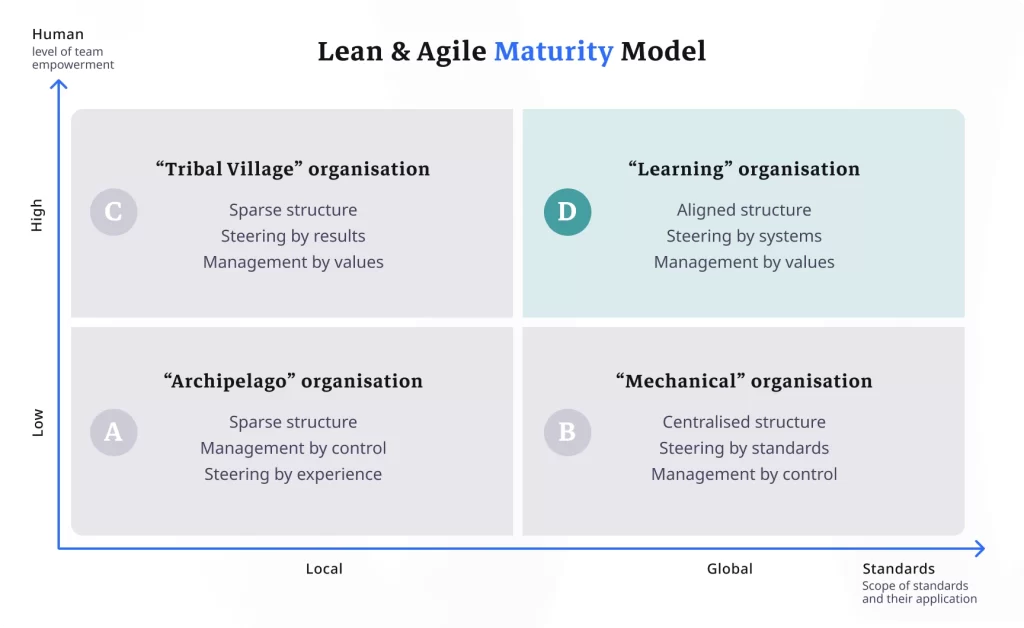
This dial represents the target model for Lean organizations: teams are autonomous, committed, and standards are widely disseminated and integrated. We are talking about dynamic stability, a learning culture, systems management, and cross-functional digitalization. The organization becomes resilient, adaptive, and sustainable.
For example, consider a company where teams make confident decisions, standards are clear but evolving, and problems are seen as learning opportunities. A company where Lean is not just a method… but is an integral part of the culture.
Welcome to the learning organization.
Here, the autonomy of the teams is strong. But this autonomy is not synonymous with chaos: it is part of a shared framework. Lean standards are present everywhere, but they are not straitjackets: they are compasses co-constructed, discussed, improved. Everyone knows why we do things, not just how.
“We try to show the impact that everyone can have on the world,” explained a project manager. “It is these shared values that allow us to move towards the learning organization.”
In these companies, management does not manage remotely. He is present, involved, exemplary. It gives meaning, creates bridges between the levels, and above all… he listens. Information flows in both directions, fluidly, regularly, and visibly.
“A learning organization is when everyone speaks the same language, from the board of directors to the field.”
It is also a culture where mistakes are not punished but analysed, where everyone can propose, experiment and innovate. Visual management becomes a support for reflection, not a simple showcase. Digital – like iObeya – is used to structure collaboration, cascade objectives, act on irritants, share successes.
“We’re not trying to impose iObeya everywhere, but to sow where it makes sense… then to amplify where it takes.”
It is a living, evolving dynamic, never fixed. This type of organization is neither perfect nor finished: it is in constant motion, driven by a simple but powerful conviction: we can always do better, together.
It is also a human-centric company. Where we take the time to listen to each other, to understand each other, to align ourselves. Where we seek to build sustainable systems, where performance is seen in all its dimensions: quality, cost, deadlines… but also well-being, learning and collective pride.
In short:
- Meaning at the top
- Autonomy at the bottom
- Standards in the middle
- And trust everywhere.
The model highlights that Lean transformation cannot be limited to the implementation of standards or tools: it requires a profound change in the managerial culture and a real increase in the power of the teams. The transition from one dial to another often requires targeted support, appropriate governance, and digitalization at the service of processes and not just their control.
This model provides a strategic framework to guide the Lean transformation, highlighting the importance of reconciling systematization and empowerment to build a learning, efficient and resilient organization.
Every organization needs to find its own path to Lean maturity. Some will start at the grassroots, others at the top of the table. In any case, the balance between local autonomy and global management remains the key.
Conclusion – Aiming for a sustainable and balanced Lean transformation
What we’ve learned in the field is that Lean transformation isn’t just about tools. It relies above all on the women and men who bring it to life every day.
Solutions like iObeya can help structure exchanges, make meetings more efficient, and better connect teams. But a tool, no matter how powerful, is not enough on its own. It’s the way we use it, together, that makes the difference.
To be successful, you must:
- Putting people at the centre of change,
-
Align objectives between managers and field teams,
- Support middle management, which is often caught between several constraints,
-
And organize clear communication between all levels of the company.
In this context, the Lean maturity model becomes a valuable aid. It’s not just an evaluation tool, it’s a guide to move forward step by step, give meaning to what you do, and change the company’s culture in a sustainable way.
Change takes time, but with the right direction, a shared vision and the right support, like iObeya, it becomes possible to progress with confidence and serenity.

